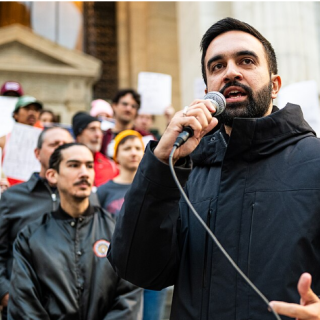Between deep Medicaid cuts and a ballooning budget for an increasingly fascistic Immigration and Customs Enforcement (ICE), the recently passed federal budget contained grim news for just about everyone in the country. While MAGA-land rejoices at the bill’s passage, recent climate-related disasters show that everyone will suffer under this “Big Beautiful Bill”. The legislation guts Joe Biden’s 2022 Inflation Reduction Act (IRA), eliminating tax credits for renewable energy and electric vehicles — a move that will cost Ohio billions in investment and thousands of jobs. Even Trump’s most rabid white nationalist supporters will live in the hotter, more disaster-prone, and volatile climate system that this climate rollback will help to usher in — right along with the rest of us.
Environmentalists reacted with shock and dismay that the IRA — the U.S.’ first and only real climate legislation — could be so easily cut to ribbons. While this development is horrifying, it is also clarifying. It demonstrates that in the current political environment, IRA-style “business-oriented” climate policies that rely on the private sector to accomplish climate goals will not stand up to an increasingly radicalized far right. Democrats must think bigger — or face dire consequences.
In the past, the Republican Party could be counted on to reliably support the interests of big investors and the largest corporate shareholders. The old Republicans typically resisted government intervention in the economy, but at least some of them (like John McCain) favored moderate, market-based environmental policies. As Jonathan H. Adler of the CATO Institute outlines, it was primarily grassroots conservative activists, not big businesses, that pushed the party into a more rigid anti-environmental stance. Donald Trump severed the party from its business allegiances once and for all by mobilizing this grassroots base towards an extreme right-wing agenda.
Since his ascendancy in 2016, Trump has hunted the old breed of Republican to near-extinction, wielding the party’s white working-class and evangelical Christian base against any elected Republican who resisted him. Party elites have learned to live in fear of a MAGA primary challenger and ostracism within the party for resisting. The old guard either retired from politics (like Mitt Romey) or bent the knee to MAGA (like Lindsey Graham). After Trump’s 2020 general election loss, the party was momentarily without a standard-bearer, resulting in factional struggles — but his 2024 victory solved this problem easily.
The new authoritarian party structure has enabled a high degree of discipline in service of an extreme and unpopular right-wing agenda. Congressional Republicans didn’t care that renewable energy lobbyists resisted the IRA cuts, that financiers decried the bill’s increases to the deficit, or that the Medicaid cuts poll poorly. What mattered was that Donald Trump wanted the bill to pass, and that was enough.
In light of these developments, it is urgent to reconsider how the design and rollout of the Inflation Reduction Act left it vulnerable to such an unceremonious and premature end. Reporting has emphasized that the bill was designed to target investment towards Republican-leaning districts, creating a dependence on the tax credits that would mobilize local interests to defend the law. Unfortunately, the IRA was mainly successful at mobilizing corporate lobbyists — and members of an authoritarian political party like today’s GOP will easily brush off any lobbyist who asks them to subvert their leader. The only way to secure durable climate legislation in the 2020s is to prevent Republicans from taking office in the first place. This requires building a large base of working-class supporters who will turn out in elections.
The IRA failed at this in several respects. First, the bill was too small to make an immediate impact on the lives of most Americans. A 2024 survey by the Yale Program on Climate Change Communication found that only 39% of Americans had even heard of the law. While Republicans denounced the IRA as a version of the “Green New Deal”, it was already a far cry from that progressive dream. Bernie Sanders’ 2020 campaign put forward a Green New Deal proposal for $16.3 trillion in federal investment, a sum that would have been impossible to ignore. Joe Biden’s original “Build Back Better” plan shrunk that to a paltry $555 billion, and to secure conservative Senator Joe Manchin’s endorsement, Biden cut it further to $391 billion.
Compared to climate-related legislation that has actually passed, the IRA was historic. But compared to its forgotten predecessors, it was a weak effort. The compromises that enabled its passage condemned it to die a quiet death — a fate foretold by the billions of dollars in IRA grants to nonprofits and municipalities that Trump had already been cancelling through executive authority on shaky legal grounds.
Second, while the IRA created jobs, it made minimal guarantees for pay, job quality, and collective bargaining. As Michael Levien writes, this was also a departure from the Green New Deal framework, which called for “ensuring. . .high-quality union jobs”. The IRA’s labor regulations came in the form of a requirement for companies receiving the tax credits to hire “registered apprentices” learning a trade, and a requirement that companies pay workers the “prevailing wage”, defined by the Department of Labor as “the average wage paid to similarly employed workers in a specific occupation in the area of intended employment”. But these provisions did not go far enough to transform a renewables sector defined by middling pay rates and low unionization.
The United Auto Workers union reports that while 17% of fossil fuel workers were unionized as of 2023, only 4 percent of solar workers and 6 percent of wind power workers were. Solar installers’ median income was just under $45,000 — 40 percent less than fossil fuel workers. Renewable energy companies receiving IRA credits continue to employ aggressive anti-union tactics similar to those of any other American corporation.
A greater quantity of these mediocre jobs will not generate much excitement among rank-and-file workers. But stronger labor standards that force companies to bargain with unions as a condition of government support could alter this picture significantly. Governments already employ such a tool by requiring “project labor agreements” (PLAs) — union contracts that set the terms of employment for the duration of a construction project — in certain cases. The Biden administration “encouraged” PLAs under the IRA, but with no legal requirements or penalties, corporations could easily ignore this.
Finally, the IRA was undermined by its reliance on private investment to accomplish climate goals. As economist Daniela Gabor has argued, the law employed a “derisking” framework which “enlists private capital into achieving public policy priorities by tinkering with risk/returns on private investments.” By providing tax credits to renewable energy companies and households who bought electric cars or installed solar panels, the IRA raised expected returns on these investments while lowering their risk by offering some guarantees to investors.
But other economic forces counteracted these effects. In recent years, rising inflation resulted in increased costs of equipment and facilities for renewable energy producers globally. Efforts to tackle inflation by central banks like the U.S. Federal Reserve by raising interest rates exacerbated this problem by increasing borrowing costs, which further depressed returns. Because renewable energy projects have such high upfront costs, they are particularly vulnerable to the interest rate environment. Analysts have acknowledged this has slowed the pace of investment. The tougher environment was particularly destructive to the offshore wind sector: while states in the Eastern U.S. have awarded contracts for 21 gigawatts of offshore wind capacity, as of 2023 BloombergNEF was estimating that only 15 gigawatts would be successfully installed by 2030 amid a wave of project cancellations.
The task of green investment is too important — and too urgent — to be left to the vagaries of the market. To ensure that green projects are successfully completed at scale, the federal government should not merely make payments to private investors who decide to go green — it should make direct investments itself. Unlike private investors, governments are not constrained by the need to make profit or receive interest payments on a deadline. And as Modern Monetary Theorists like Stephanie Kelton emphasize, any government that mints its own currency doesn’t need to worry about repaying debts. It can make direct investments by creating new money and directing it towards social purposes, or it can pay off any debt it chooses to incur through money creation. The only real constraint on this is inflation, which can be remedied through well-placed taxes.
If the idea of direct government investment sounds outlandish, let’s recall that it has already been done at a large scale in recent history. During the Great Recession and again when COVID-19 struck, the Federal Reserve purchased huge quantities of U.S. Treasuries and mortgage-backed securities to flood the financial markets with cash. During COVID, the Fed took the groundbreaking step of making direct, low-interest loans to corporations and midsize businesses.
A program of green public investment would simply mean that interventions like these are made to accomplish social and environmental goals, rather than mere crisis stabilization — and that decisions about where to invest are made by democratically elected politicians rather than unaccountable financial bureaucrats. As an added bonus, such investments need not enrich wealthy investors, but could be used to create shares in publicly or cooperatively owned companies that would further help redistribute wealth downward and secure working-class political support.
Only by embracing these more radical measures will Democrats ensure that federal climate dollars benefit enough everyday people to tip the scales of future elections. This must occur at the nearest possible window of political opportunity. We are running out of time to get it right — for both democracy and the planet



